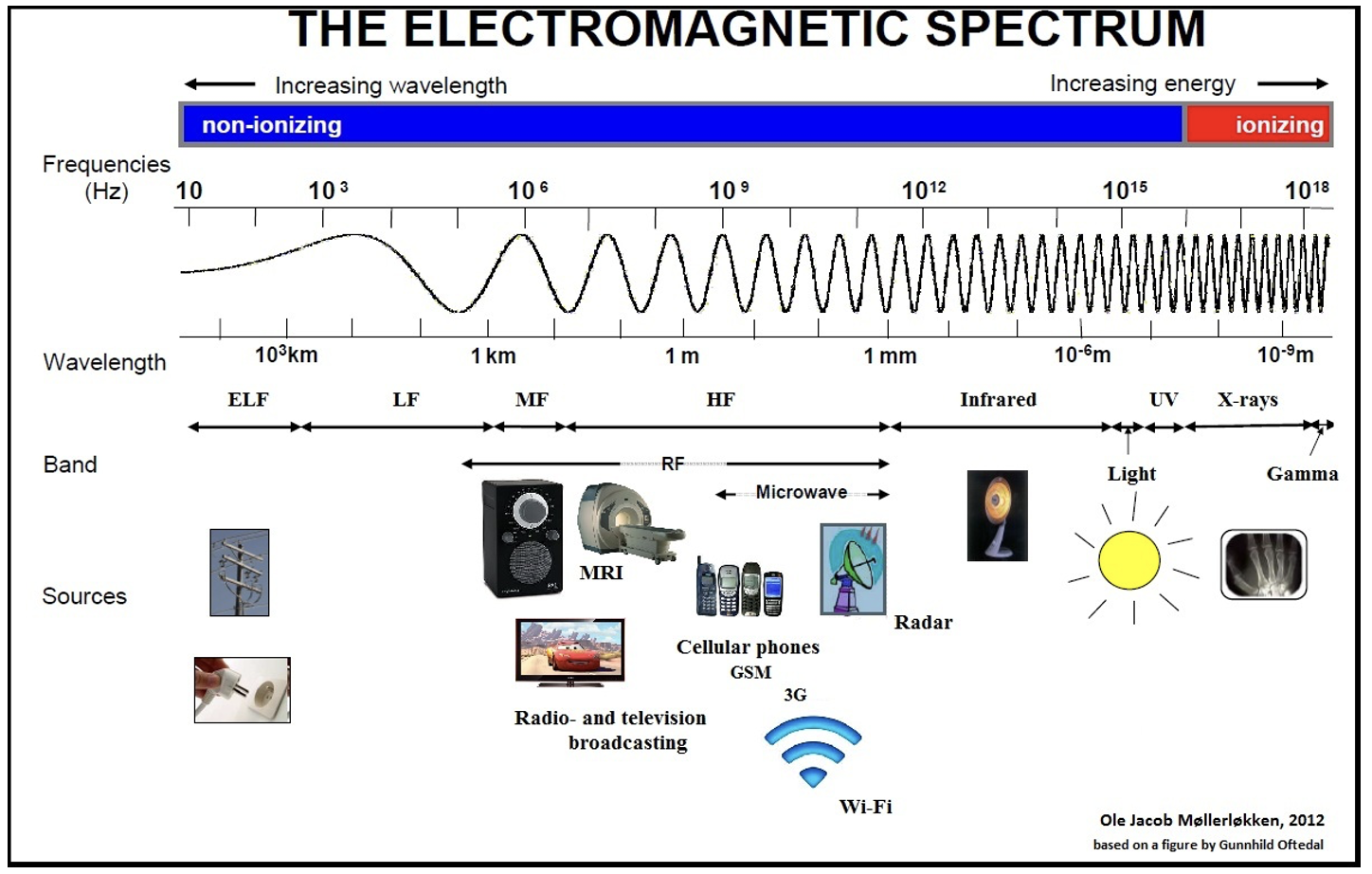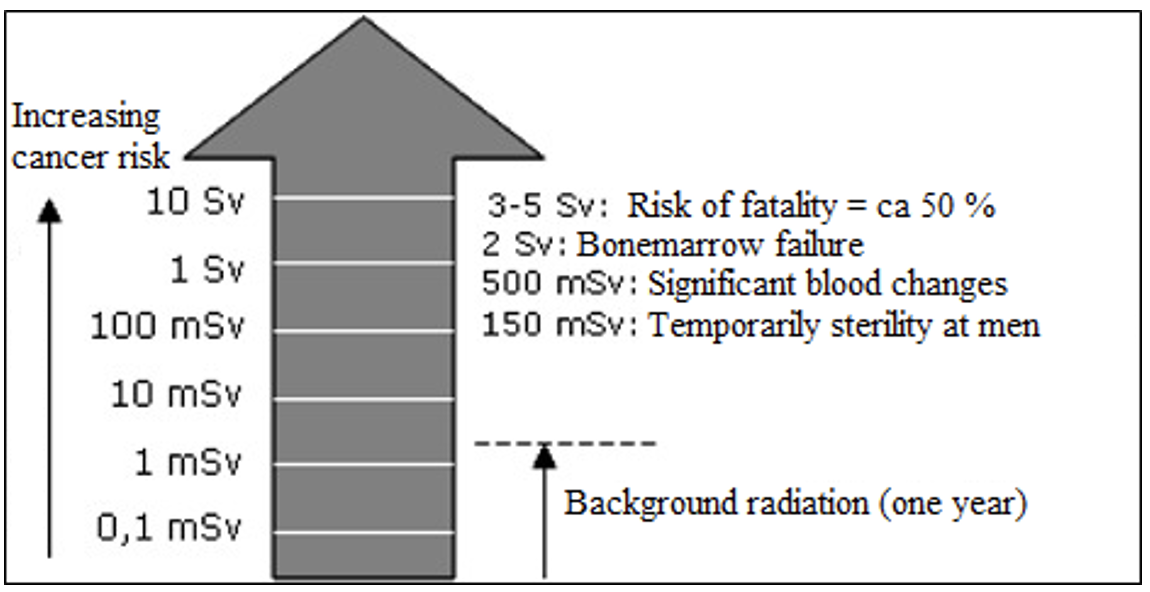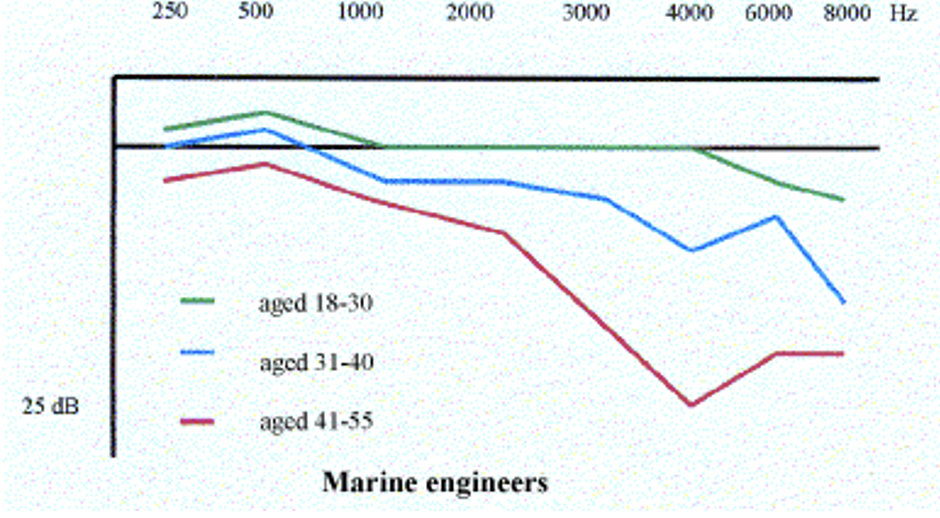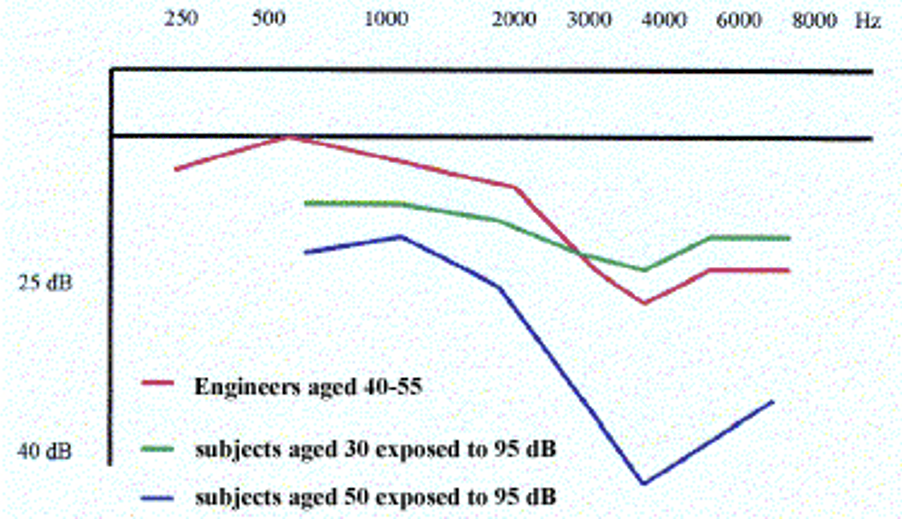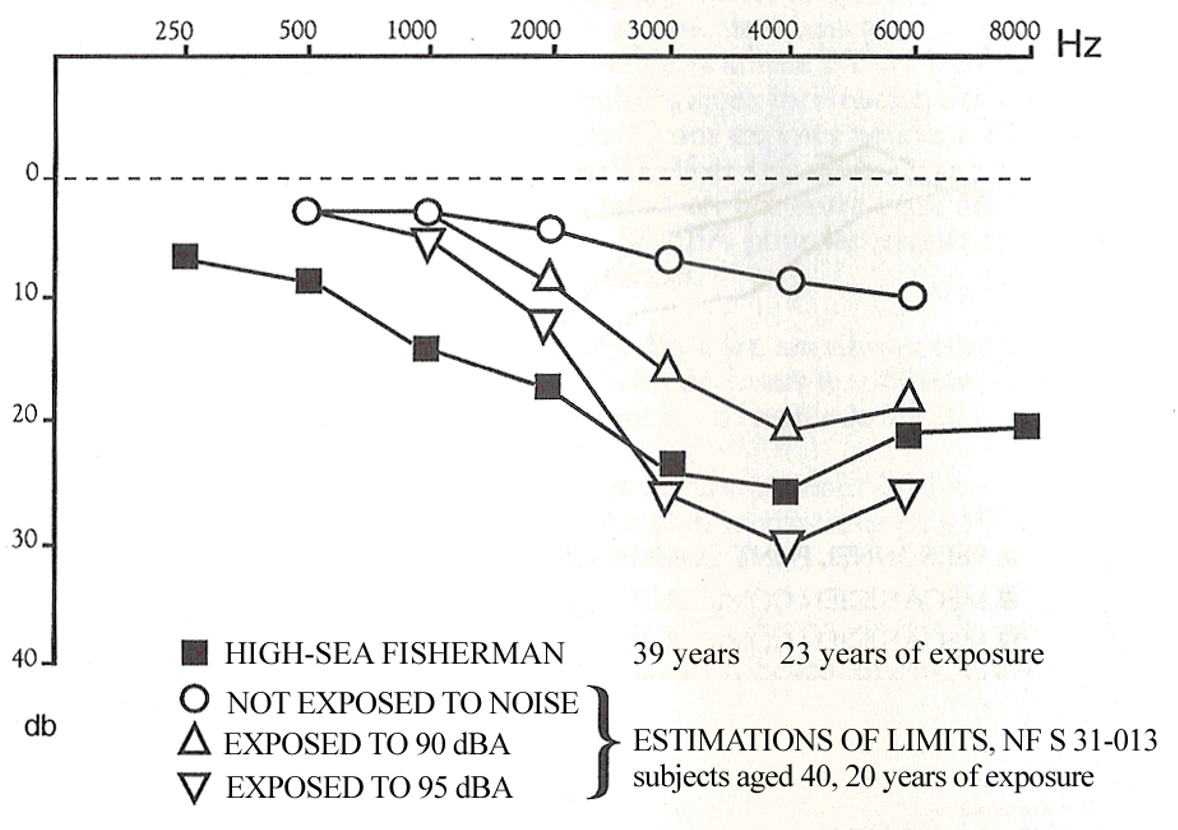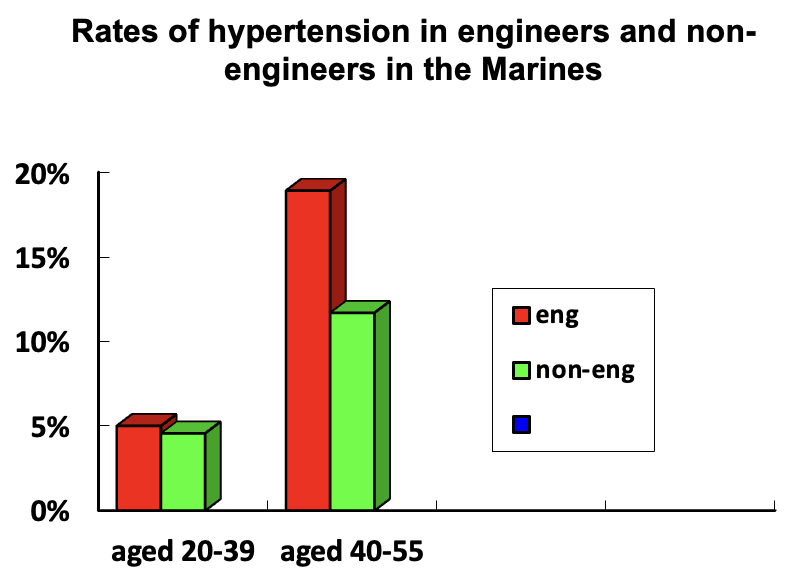E.4 Chemical Substances
- Details
TIM CARTER, RUNE DJURHUUS, MAGNE BRÅTVEIT
Risk assessment
CARTER/DJURHUUS/BRÅTVEIT
It is essential to establish the properties of a substance found on board. The chemical manufacturer or exporter for all hazardous materials must supply a Material Safety Data Sheet (MSDS) and this contains a summary of the important health, safety and toxicology information on the ingredients of the chemical or mixture. A current MSDS, no more than two years old, should be available for every hazardous chemical agent transported or in use on board. Containers holding hazardous substances must also be labelled with appropriate warning and identification labels. Such information is not always supplied for materials that are carried as cargo, for instance wood products or scrap metal that may lead to a build up of toxic gasses in the hold or grain cargoes that may either be contaminated with fumigants or have the potential to cause allergic responses. Here it may be necessary to search in open access databases such as the USA National Library of Medicine ‘Pubchem’ database[1], trade or scientific literature to establish risks. Some substances may also pose other risks, such as fire and explosion or environmental damage that also need to be taken into account.
A risk assessment is required to determine the risk of exposure and if it is at a level that can be expected to cause harm. This must include:
- Can the substance enter the body?
- How much of the substance enters the body?
- Does the substance cause immediate adverse effects?
- Does the substance have long-term health effects?
Can the substance enter the body?
The main routes of entry are:
Inhalation
This is the most important route of exposure. The surface area of the lungs is very large and designed for the process of gas exchange. Any hazardous gases or vapours inhaled into the lungs can have a direct effect on the surface of the lungs but can also be absorbed like oxygen is in the breathing process. Once absorbed into the blood stream, hazardous gases and vapours can be transported around the body and have an effect on organs such as the liver, kidneys and blood.
Dust and fibres can also be inhaled. The upper parts of the respiratory systems have some mechanisms to trap and remove dust and fibre. However very fine particles and fibres can be inhaled into the deep lung where the body is not able to remove them. Dusts and fibres can have effects on the surface of the lungs. Soluble dusts and fibres can also be dissolved and absorbed into the body.
Skin contact or absorption.
Some hazardous substances can cause irritant or allergic reactions when they come into contact with the skin. Substances that are soluble in fat can pass through the skin and be absorbed into the blood stream, circulate in the body and have an effect on organs within the body. If there is a cut or abrasion in the skin, absorption can occur even more quickly.
Gases and vapours can also be absorbed in the same way through contact with the eyes.
Ingestion.
Most people do not swallow harmful substances on purpose, however it is possible to accidentally ingest a toxin while eating, drinking or smoking after work with chemicals. This occurs when chemical substances on hands and clothing contaminate food, drink or cigarettes. Ingestion can also occur where dusts and fibres trapped in the upper parts of the respiratory system are coughed up and swallowed. It may also occur when chemicals are stored in unlabelled containers, particularly those normally used for food or drink. Outside of the working environment, medicines, substances such as alcohol and illicit drugs as well as allergens and other toxins in food may be ingested and cause adverse effects.
Injection
Substances may be injected or pushed into the skin, such as in the case of needle stick injury or from high pressure applications such as pressure washing, grit blasting, fuel injectors or hydraulic systems.
How much of the substance enters the body?
CARTER
High levels of exposure over short periods are critical if the substance can cause immediate harm. Average exposures over the day, month or year will determine the risk of long-term damage to health. The MSDS should provide information on methods for assessment of uptake and on the level of risk and precautions needed in common conditions of use. Occupational Exposure Limits (OELs) have been set for many commonly encountered substances. Gas testing devices or indicator tubes can be used to assess short-term exposure levels for substances causing acute health risks, while monitoring of exposure over a shift or, occasionally, measuring the levels of the substance or its breakdown products in breath or urine can be used for chemical substances associated with longer term health risks.
National and international agencies publish lists of OELs for a wide range of commonly encountered substances. These are subject to change in the light of new evidence on risk and up to date sources should be consulted. If exposure to a chemical substance with an OEL is anticipated then it may be necessary to carry the appropriate means for measuring the level and using it in a risk assessment prior to performing tasks that carry a risk. However, risk assessment needs to also be done for the numerous substances that do not have an OEL and/or for substances where methods for measurements are not available.
Does the substance cause immediate adverse effects?
Seafarers may be exposed to many substances that can cause immediate adverse effects. These include:
- chemicals in the cargo
- compounds emitted from the cargo
- chemicals used for running the ship like lubricants and fuel
- chemicals used for maintenance work such as cleaning, removing rust and painting
- chemicals used for the eradication of pests (fumigants)
A report of injuries by chemicals on approximately 800 Danish merchant ships between 1988 and 1996 noted 177 injured seafarers, of which 13 cases were fatal including two suicides[2]. Cases included alcohol intoxication, corrosive agents on eyes and skin, inhalation of solvent vapors, gases like hydrogen sulfide and propane, welding fume and chemicals used for cleaning etc. 63 % of the cases were corrosive damage to the eyes and skin, in the remainder, inhalation was the primary route of exposure.
Corrosive damage is often due to weak acids like acetic acid or strong acids like sulfuric, hydrochloric or nitric acid. Damage may also be caused by strong basic products like ammonia and caustic soda, which are particulary damaging to eyes. Knowledge of how to handle (mixing and diluting) acids and bases are crucial, as well as the use of personal protective equipment (see below)
The use of solvent-containing materials (e.g. paint) require sufficient ventilation and /or use of protective equipment.
Does the substance have long-term health effects?
Information about long-term health risk in seafarers is limited (see Ch xx). Historically the effects of excessive exposure to a few substances have been identified, for instance from exposure to asbestos and associated with hydrocarbon cargoes such as benzene. Often information from onshore experience has been extrapolated to seafarers and forms the basis for risk management, for example in controls on the carcinogens asbestos and benzene.
Risk Management for substances
CARTER
The principles of risk management in Ch xxx are applicable to chemical substances. Personal protective equipment is widely used in the maritime sector, especially for performing short-term tasks where there is a risk of high-levels of exposure. However this should be the ‘last line of defence’ in managing the risk of exposure and should be used alongside other, preferred control measures. The choice of protective equipment is determined by the hazards of the substances present.
Respiratory Protective Equipment (RPE)
Respiratory Protective Equipment (RPE) is required when engineering and administrative controls are not sufficient to protect a worker from a hazardous atmosphere, and:
- a worker is or may be exposed to an airborne contaminant (or mixture) in a concentration exceeding the occupational exposure limits (OEL) or
- the atmosphere has or may have an oxygen concentration of less than 19.5% by volume.
It should first be deemed essential to continue with the task at that time.
RPE must be properly fitted, used and maintained to remain effective. The selection of respirators should be documented and based on:
- The nature of the contaminant
- The concentration or likely concentration of any airborne contaminant
- Duration of exposure
- The concentration of oxygen
- The warning properties of the contaminants (odour, taste, irritation)
- The need for emergency escape
- Routes of exposure and health effects relevant to the contaminant Estimate of exposure using supporting evidence (e.g. occupational exposure monitoring)
- The Assigned Protection Factor (APF) of the RPE
Types of RPE:
Air-Purifying respirators remove the contaminant from the breathing air by filtration or chemical absorption.
They may only be utilised when all of the following criteria are met;
- Contaminants are present in concentrations less than are immediately dangerous to life or health (IDLH).
- Oxygen concentration must be between 19.5 – 23.5%.
- Non-emergency situations, where concentrations are known
Air Purifying Respirators should not be used for Hydrogen Sulphide (H2S) at concentrations greater than 10ppm.
Disposable filter masks are of limited use. They are designed solely for nuisance dusts and particulates, aerosols, or fumes at low concentrations.
Breathing Apparatus /Air-Supplied respirators provide clean air from an uncontaminated outside source or from a tank.
They should be used in situations where there is a potential for:
- Conditions could be immediately dangerous to life or health (IDLH)
- The atmosphere may be oxygen-deficient (Below 19.5 %.)
- Chemical concentrations are greater than those where air filtrating respirators are sufficient to reduce exposure to a safe level
- Concentration of contaminants are unknown
Storage & Replacement of RPE
RPE should be stowed in a clean bag or container
Disposable masks should be changed at the end of every shift or if they become heavily contaminated.
Re-usable equipment should be fully cleaned and sanitised between users. The fit should be checked when a new user is required to use RPE. Where use is regular and it is feasible, facemasks should be allocated to individuals.
Particulate and gas filters should be changed at intervals determined as in the task risk assessment bases on the supplier’s instructions and the relevant MSDS.
Protective Clothing (including gloves)
Where there is risk of skin contact the primary focus should be to prevent exposure or control it by engineering measures or work practices. However, where it cannot be guaranteed that skin contact with chemicals will not occur chemical-protective clothing may be required.
A substance can pass through protective clothing to reach the skin in three ways:
- Penetration through tears, pinholes, openings and seams.
- Degradation of the material.
- Permeation through the body of the intact material.
The chemical-protective clothing material to be used will depend on the substances present, for instance many chemicals will penetrate normal rubber gloves and nitrile rubber, which is more resistant to penetration needs to be used.
Eye & Face Protection
Eye and face protection includes safety glasses, chemical goggles and face shields. The correct type of protection is chosen based on the hazard. Safety glasses can protect from flying particles of debris, but they do not keep toxic or corrosive liquids out of the eyes, and so goggles or face shields are needed.
Many chemicals can cause significant harm to the eyes and skin if they come into contact. Health effects may include corrosive burns, irritation or allergic
reaction. It is important that the protective device be worn at all times when the hazard is present.
Skin damage
Repeated exposure of the skin to either irritant or allergy producing substances may lead to the development of skin rashes and soreness (dermatitis). This is seen in the catering department from prolonged contact with strong detergents, in engineers from the use of solvents to clean components and in deck crew from some paint systems. Protective measures include the regular use of gloves, careful attention to skin cleaning and the use of skin reconditioning creams. Referral for medical advice in port may be needed.
Common Substances Hazardous to Health, their Risks & Controls in the Shipping Industry
CARTER
Asbestos
Risk assessment
Asbestos is a naturally occurring silicate mineral fibre that has historically been used for its thermal resistance and non-conductive properties. It has been used in a huge range of applications including insulation, insulating boards and doors, gaskets, rope seals, floor and ceiling tiles, cement roofing.
Asbestos is now a banned material in many countries. However the mining and production of white asbestos (chrysotile) continues in some countries. Use of asbestos in the shipping industry is prohibited, however with equipment and construction materials supplied from all over the world and used by many sub-contractors in the ship building industry, companies must remain alert to checking that the materials used and installed on our ships are asbestos free.
Health Effects
Asbestos is a risk to health via inhalation. If asbestos containing materials degrade or are damaged, microscopic fibres not visible to the naked eye can be released. These fibres can be inhaled into the deep lung and the body has no defence mechanisms to break these fibres down or remove them from the lung once they have been inhaled. The fibres can have a range of health effects on the lungs from scarring which affects breathing, through to lung cancer and mesothelioma (cancer of the pleural lining of the lung). The risk of developing health effects from asbestos increases with the intensity and duration of exposure.
There is no ‘safe’ limit for exposure to asbestos. Health effects have a long latent period, and may take 10-40 years to develop.
Exposure Limits
Occupational Exposure Limits for asbestos, usually based on the measurement of an 8-hour time weighted average, have been set by most countries and form the basis for deciding on the control measures required.
Risk management
- Stipulate no asbestos containing materials when ordering new equipment, parts or materials
- Where asbestos exists, try to find a way of doing the work without disturbing materials that contain asbestos, or are suspected of containing asbestos.
- Enclose the materials under negative pressure.
- Damp down materials to prevent fibre release
- Segregate work activities
- Use barriers / warning signs
- PPE: Disposable coveralls and nitrile gloves tucked inside the coverall wrist. The coveralls should be taped at the wrists and ankles. If safety boots with laces are being worn, the laces must be covered with tape.
- RPE: Type should be determined by the level of risk associated with the task. A P3/P100 particulate filter and half facemask is a minimum requirement.
- HEPA filter vacuum cleaner to collect waste. E.g. class H vacuum cleaner to BS EN 60335 standard.
Welding Fume
Risk assessment
Welding fume is a mixture of airborne gases and particulate.
More than 90% of the particulate arises from vapourisation of the consumable electrode, wire or rod as material is transferred across the arc or flame. The remainder is from vapourisation of the metal forming the work piece.
Additional gases may include:
- Fuel gases which, on combustion, form carbon dioxide and sometimes carbon monoxide
- Shielding gases such as argon, helium and carbon dioxide, either alone or in mixtures with oxygen or hydrogen
- Carbon dioxide and monoxide produced by the action of heat on the welding flux or slag
- Nitric oxide, nitrogen dioxide and ozone produced by the action of heat or ultraviolet radiation on the atmosphere surrounding the welding/cutting arc
- Gases/vapours from the degradation of solvent vapours or surface contaminants on the metal.
Health Effects
The degree of risk to the welder's health from exposure to the combination of particulate & gases associated with welding will depend on:
- Fume/Gas/Vapour composition
- Fume/Gas/Vapour concentration
- Length of time the welder is exposed
- Welder's susceptibility
Health effects can include;
- Irritation of the respiratory system that can have serious consequences in the deep lung.
- Asphyxiation
- Metal fume fever - Breathing in metal oxides such as iron, zinc and copper can lead to an acute flu-like illness called 'metal fume fever'. It most commonly occurs when welding/cutting galvanised steel. The symptoms usually begin several hours after exposure with a thirst, cough, headache sweat, pain in the limbs and fever. Complete recovery usually occurs within 1 to 2 days of removal from the exposure, without any lasting effects.
- The continued inhalation of welding/cutting fume over long periods of time can lead to the deposition of iron particles in the lung which can make breathing difficult and painful.
- In certain welding/cutting situations e.g. welding stainless steel, there is a potential for the fume to contain forms of chromium and/or nickel compounds. These substances can cause cancer in humans.
Exposure Limits
The Occupational Exposure Limit for welding fume are for long term exposures to respiratory particulates. In addition the limits for the gasses present also need to be considered.
Exposures On-board
- Dry-dock/repair periods; fabrication in engine room workshop.
- Welding operations during vessel repair, maintenance or modification
Risk management
- Eliminate the need for welding, or substitute the welding process/materials for those with less hazardous properties.
- General dilution ventilation
- Local extract ventilation
- Administrative/organisational - People segregation, time limited exposures
- Personal Protective Equipment
- Respiratory Protective Equipment
Hydrocarbons / Volatile Organic Compounds (VOCs) / Benzene
Risk assessment
Hydrocarbon liquids such as crude oil contain Volatile Organic Compound (VOC) components. A VOC is any compound of carbon, excluding carbon monoxide, carbon dioxide, carbonic acid, metallic carbides or carbonates, and ammonium carbonate, which react in the atmosphere.
VOCs evaporate or change from a liquid to a vapour easily. The VOC vapours can then mix with air. The concentration of VOCs that could be present in the air from crude oil depends on a number of factors including
- the amount of oil that comes into contact with the air,
- if the oil has been washed by water,
- the temperature and pressure of the air that the crude comes into contact with.
Examples of VOCs in hydrocarbons include benzene, toluene, ethyl benzene and xylene. These are all hazardous substances. Benzene is highly toxic. It is present in varying quantities in some petroleum products that may be carried on oil and gas ships. Benzene is a highly flammable, volatile solvent that can enter the body through inhalation or absorption.
Health Effects
Hydrocarbons are a risk to health if the volatile vapours are inhaled or liquid/vapour is absorbed through the skin. Once inside the body they can have a range of health effects ranging from headaches, dizziness and nausea through to liver damage and cancer.
Exposures On-board
Exposures to hydrocarbons are a risk during tank cleaning, cargo tank entry, gas freeing, gas testing, loading and discharging operations on oil and gas ships and during bunkering operations on all vessels in the shipping industry. Paints and cleaning solvents are commonly hydrocarbon based and exposure can occur in engine areas and during routine ship maintenance.
Risk management
- Dilution/forced ventilation
- Respiratory protective equipment (RPE) - the level of RPE should be selected based on the level of risk. As a minimum a half face respirator with an organic vapour cartridge mask should be used. The risk assessment should determine when the cartridge should be changed. The concentration of hydrocarbon in air, temperature and humidity must be taken into account.
- Nitrile gloves
- Disposable chemical protective coveralls
- Precautions for entry into confined spaces (cross reference)
Carbon monoxide
Risk assessment
Carbon monoxide (CO) is an odourless gas with a similar density to air. Commonly produced by partial combustion of carbon containing materials including tobacco, and from metabolic processed affecting some organic substances.
Health Effects
CO is absorbed through the lungs. It binds firmly, but reversibly, to the haemoglobin in the blood that transports oxygen from the lungs to the tissues. As a result, the body is starved of oxygen. Low level exposure results in feelings of unease, usually with a headache. High level exposures can cause immediate unconsciousness and death. Removal from exposure and breathing fresh air or oxygen, if done in time, will enable the CO to be displaced by oxygen and exhaled.
Exposure Limits
Exposure limits for an eight-hour working day vary internationally but all are set at less than 50 parts per million. A concentration of 800 ppm can be fatal within an hour and a concentration above 10,000 ppm is fatal after a few breaths.
Exposures on board
CO will be present, but usually at a low level, in diesel engine uptakes and in poorly ventilated areas where there is heavy smoking. Higher concentrations have been found on the car decks of ro-ro ferries when petrol engine vehicles are loading and unloading. Similar exposures may arise if outboard motors or other petrol engines are tested in poorly ventilated spaces. The highest and potentially deadly concentrations occur with shipboard fires and from wood pellet cargoes. Pellets produce CO and this accumulates in storage. These cargoes have caused maritime fatalities when holds and adjacent service passages are entered without prior ventilation or appropriate breathing apparatus.
Risk management
- Venting / general ventilation
- Breathing apparatus/ air supplied respirators for firefighting and for entry to high risk cargo areas
- Precautions for entry into confined spaces. More information can be found in Ch xx.
Carbon dioxide
Risk assessment
Carbon dioxide is the main product from the respiratory processes of living organisms. Hence, it is produced and exhaled by people, and produced by many living cargoes such as grain. It is colourless and odourless and, as it is heavier than air, it may accumulate in hollows and sumps, sometimes asphyxiating by displacing oxygen (see below).
Health effects
At concentrations well in excess of those in exhaled breath, carbon dioxide has toxic effects leading to confusion, and loss or consciousness. All are reversible by removing the person to fresh air, provided the symptoms are detected early.
Exposure limits
The UK has set exposure limits of 5000 ppm for an eight-hour working day with a maximum level of 15000 ppm for a 15 minute period.
Exposures on board
Carbon dioxide is a normal product of combustion and so is present in diesel engine uptakes. Higher levels are likely to be present where flu gasses have been used to inert tanks holding flammable liquids. Entry to such tanks may pose an immediate risk unless breathing apparatus is used. High concentrations, usually together with low levels of oxygen may be present in enclosed spaces, such as holds and access routes where organic cargoes that are actively respiring such as grain or logs are carried.
Risk management
- Venting / general ventilation
- Breathing apparatus/ air supplied respirators for entry to high risk cargo areas and enclosed spaces
- Precautions for entry into confined spaces. More information can be found in Ch xx.
Lack of oxygen/hypoxia
Risk assessment
Oxygen is essential to life and forms at a concentration of around 20% of the atmospheric pressure at sea level. However, we are unaware when concentrations fall, even to dangerously low levels.
Health effects
Oxygen is transported from the lungs around the body by the red pigment, haemoglobin, in the blood. All the tissues in the body need a constant supply of oxygen to function. In particular, if the supply of oxygen to the brain ceases for more than 1-3 minutes it is permanently and usually fatally damaged. If no damage has occurred any effects are reversible with fresh air.
Exposure limits
At sea level, precautionary levels have been set at 19.5%, in part because a reduction in oxygen indicates that another potentially toxic gas may be present. Levels below 10% will cause rapid impairment and increase the risk of loss of consciousness and fatality.
Exposures on board
Oxygen deficiency commonly occurs in confined spaces, such as chain lockers where rusting or other oxidative processes have taken place. It is intentional where inert gasses have been used to blanket a flammable liquid cargo. It also occurs in cargo areas where the contents take up oxygen either for respiration, as with living cargoes such as grain, or because of chemical oxidation, as with some types of metal scrap.
Risk management
- Venting / general ventilation
- Breathing apparatus/ air supplied respirators for entry to high risk cargo areas and enclosed spaces
- Precautions for entry into confined spaces. More information can be found in Ch xx.
Hydrogen Sulphide (H2S)
Risk assessment
Hydrogen Sulphide (H2S) is an extremely toxic, flammable, corrosive/irritant gas.
It is heavier than air and may accumulate in low-lying areas. At low concentrations it smells like rotten eggs, but it quickly paralyzes the sense of smell and therefore odour alone cannot be relied on as a warning.
Health Effects
H2S gas affects health when it is inhaled. It travels directly through the lungs and into the blood stream. There is a range of health effects depending on the concentration of H2S in the atmosphere that is inhaled.
Exposure Limits
Occupational Exposure Limits for hydrogen sulphide are set for both long-term exposures (8-hour time weighted average) and short-term exposures (15-minute time weighted average).
Exposures on board
Hydrogen Sulphide can be present in high concentrations in un-stabilised crude oil & gas and in high sulphur residual fuel oils. The risk of exposure exists during loading, discharge, gas testing and during bunkering operations. As Hydrogen Sulphide is also produced in the natural decomposition of organic matter, exposure can also occur in sewage systems and where stagnant water has collected.
Risk management
- Venting / general ventilation
- Breathing apparatus/ air supplied respirators must be used for hydrogen sulphide exposures where concentrations in the air are in excess of 10ppm
- Precautions for entry into confined spaces. More information can be found in Ch xx.
Cargo, bunker and ballast residues – sludges
Risk assessment
Deposits may remain in both fuel and bulk cargo tanks when liquid contents have been pumped out. Such residues vary widely in composition. They may include large molecular weight hydrocarbons, a few of which are carcinogenic. Heavy metals may also be present, some toxic and a few weakly radioactive. Where natural products have been carried and when ballast water has been drained, a range of organisms, alive or dead may be present. Such sludges pose both potential health and environmental risks.
Health Effects
These will depend on what is present. The routes by which any contaminant can cause harm to crewmembers is either by skin contact, liquids and solids, or inhalation, volatile liquids or dusts. There will be exposure limits for only a few of the potential contaminants and a general precautionary approach is needed.
Sludge removal often also involves the use of strong and sometimes corrosive cleaning agents. These too require precautionary measures to prevent harm.
Risk management
- Venting / general ventilation
- Breathing apparatus/ air supplied respirators for entry to high risk cargo areas and enclosed spaces
- Skin and eye protection, and provision of eyewash facilities
- Precautions for entry into confined spaces. More information can be found in Ch xx.
Residues in engine uptakes
The exhaust gasses from engines contain both particles and vapours from incomplete combustion of fuel. If residual fuel oil is being used for propulsion they may also contain heavy metals and other materials present in the fuel, or in any oils that have been blended with it. These may be deposited in uptakes and funnel vents and require removal. The exhaust gasses themselves will be oxygen deficient and contain carbon dioxide, see above, as well as particulates and vapours.
Health effects
Some organic compounds produced by partial combustion can be carcinogenic. These may be present at low concentrations in soot and other deposits. Some residual fuel oils contain the element vanadium and this can cause respiratory problems. Bunkering companies sometimes dispose of industrial waste oils in fuels and these can contain a wide range of other contaminants. Residues are variable and complex, hence no single exposure limit is applicable.
Risk management
- Work practices must ensure that no sources of exhaust gasses can be operating while maintenance or cleaning of an uptake is in progress.
- Venting / general ventilation
- Breathing apparatus/ air supplied respirators for entry
- Skin and eye protection,
- Precautions for entry into confined spaces. More information can be found in Ch xx.
Fumigants
DJURHUUS, BRÅTVEIT
Risk assessment
Freight containers and bulk cargo ships are frequently treated with pesticides to prevent the deterioration of cargo by pests and the spread of unwanted organisms. These pesticides, which are by their nature toxic to pests, are often also dangerous to humans. They are termed fumigants due to their usual administration in a gas phase through a fumigation process. The fumigants represent chemical hazards to workers carrying out the fumigation process, to port officials inspecting the containers and to workers unloading freight containers or bulk cargo ships as residues of the pesticides used may remain in the container or cargo hold. Seafarers may also be exposed to pesticides from fumigated cargo during the transport at sea.
The major fumigants used include:
- Methyl bromide
- Phosphine
- Formaldehyde
- Chloropicrin
- 1,2 Dichloroethane
- Ethylene oxide
All these compounds have significant toxic potentials, including acute and long-term effects. Formaldehyde may occur as an off-gassing product from the cargo, but is less frequently used as a pesticide in freight containers.
Health Effects
Each fumigant has a different pattern of toxic effects for humans, some are short term and likely to arise from single large accidental exposures. Others may be delayed and associated with repeated exposures over a long period of time. By their nature, fumigants are volatile and the main risks arise from inhalation. MSDS and other reliable sources of information should be used to establish what precautions and monitoring procedures are appropriate for the fumigant being used.
Fumigants in containers at ports.
Worldwide, more than 750 million container units are packed, shipped and unpacked annually, and the majority of these containers are fumigated before shipping. The common pesticides used for this purpose are methyl bromide and phosphine. When fumigated containers arrive at their destination significant concentrations of these gases can remain in the atmosphere within the container. Thus, workers unloading such containers may be exposed to fumigants if the containers are not checked and declared gas free before opening (1). In addition, authorities like the food inspectorate or customs may be exposed when opening containers for inspection. Under normal circumstances, there is no risk of exposure to fumigants for seafarers when transporting closed containers. So far there have been no reports of fatalities related to the opening of containers, but several reports have described adverse health effects among workers opening and unloading containers (2).
Fumigants on bulk cargo ships.
Pesticide is often used to treat cargo on bulk ships at the port of shipment. The cargo is often a food, such as grain, flour etc., but other cargoes such as timber are also fumigated. The pesticide used is almost entirely phosphine. Aluminium or magnesium phosphide in solid form is placed on top of or partly buried in the cargo. The phosphide reacts with water (as moisture in the air or cargo) and releases phosphine (PH3) gas as the active pesticide. The generation of phosphine may continue through the transport at sea, resulting in considerable amounts of phosphine gas present in the hold when the ship arrives at the destination. A unique feature of this way of administrating the fumigant is that the moisture/water may be limiting and cause the reaction to stop, leaving solid phosphide in the cargo. Remains of solid phosphide or empty packages/ tubes of phosphide tablets indicate the use of phosphine as a fumigant. When the holds are opened at the destination, replenishment with ambient, moist air may restart the reaction liberating phosphine gas. The pesticide then represents a hazard to the workers opening and unloading the cargo holds.
The liberation of phosphine gas during the voyage at sea, also represents a hazard to the seafarers on board. Several incidents have occurred at sea that indicate the intoxication of crewmembers due to leakage of phosphine gas from the cargo, some with a fatal outcome (5, 6). A recent review revealed a number of such intoxications and fatalities of seafarers and pointed to lack of knowledge of pesticide health hazard and poisoning symptoms and neglecting of recommended procedures as major reasons for the incidents. In addition, some vessels seemed unsuitable for cargo fumigation due to insufficient boundaries between cargo holds and crew quarters (7).
Risk management
According to IMO regulations, fumigated containers must be labelled with the proper fumigation warning marks (8). In practice, fumigated containers are seldom appropriately labelled. Containers should not be opened until a risk assessment based on shipping documents, approved measurements of the container atmosphere and/or assessment of the ventilation of the container, concludes that it is safe to do so (9). However, current container design makes safe and rapid air sampling and ventilation prior to opening the doors technically difficult. If it is suspected that containers have been fumigated they are often left to ventilate naturally even though this is documented not to be efficient. Efficient methods for degasification by forced extract ventilation exist, but it seems that only a few locations have access to such facilities.
Personal protective equipment (PPE) should be an option only when other preventive measures are not sufficient to reduce the concentration of fumigants below accepted levels. It is important to ensure regular training and instruction on the procedures and the maintenance and use of PPE.
On bulk cargo ships it is important that the ship is equipped with sensors for phosphine gas that can detect any leakage from the cargo hold, and that the crew is properly informed of the hazards and signs of intoxication. Mandatory safety procedures should be implemented when fumigated cargo is transported on bulk ships including availibility of personal protective equipment (gas masks, self-contained breathing apparatus (SCBA)) in case of accidents and the sudden release of phosphine gas.
Further information regarding safe use of pesticides can be found in IMO Maritime Safety Committee Circular 1264 (2008) (10).
References
1. https://pubchem.ncbi.nlm.nih.gov. Accessed 8th June 2021.
2. Hansen, H.L. and Pedersen, G. 2001. Poisoning at sea: injuries caused by chemicals aboard Danish merchant ships 1988-1996. Clin. Toxicol., 39(1): 21-26.
3. Baur, X., Poschadel, B.,and Budnik, L.T. 2010. High frequency of fumigants and other toxic gases in imported freight containers - an underestimated occupational and community health risk. Occup. Environ. Med., 67(3): 207-212.
4. Bråtveit, M., Djurhuus, R., Kirkeleit, J. and Hollund, B.E. 2018. Review of human health risks and prevention practises during handling of fumigated containers in ports. Report for the European Agency for Safety and Health at Work (EU-OSHA), Dept. Occup. Med., Haukeland University Hospital, Bergen, Norway, 53 pp. ISSN: 1831-9343; ISBN: 978-92-9496-814-2; doi: 10.2802/16959
5. Lodde, B., Lucas, D., et al. 2015. Acute phosphine poisoning on board a bulk carrier: analysis of factors leading to a fatal case. J. Occup. Med. Toxicol., 10: 10
6. Marine Accident Investigation Branch (MAIB) https://www.gov.uk/maib-reports/phosphine-poisoning-on-general-cargo-vessel-monika-with-loss-of-1-life
7. Djurhuus, R. 2021. Fumigation on bulk cargo ships: a chemical threat to seafarers. Int. Marit. Health, 72(3): 206-216.
8. IMO [International Maritime Organisation]. 2010. Recommendations on the safe use of pesticides in ships applicable to the fumigation of cargo transport units. Ref. T3/1.01 MSC.1/Circ.1361 London.
9. WorkSafe New Zealand. 2017. Quick guide. Keeping Safe from Harmful Substances while Inspecting or Unpacking Containers. https://www.worksafe.govt.nz/assets/dmsassets/zero/950WKS-5-work-related-health-harmful-substances-from-containers.pdf
10. IMO [International Maritime Organisation]. 2008. Recommendations on the safe use of pesticides in ships applicable to the fumigation of cargo holds. Ref. T3/1.01 MSC.1/Circ.1264 London.
[1] https://pubchem.ncbi.nlm.nih.gov .Accessed 8th June 2021.
[2] Hansen, H.L. and Pedersen, G. (2001) Poisoning at sea: injuries caused by chemicals aboard Danish merchant ships 1988-1996. Clin. Toxicol., 39(1): 21-26.
